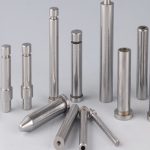Notice: Undefined index: sith_hide_share in /www/sites/alloy.wiki/index/wp-content/themes/likegoogle/single.php on line 32
Deprecated: get_settings is deprecated since version 2.1.0! Use get_option() instead. in /www/sites/alloy.wiki/index/wp-includes/functions.php on line 4862
Galvanized steel sheet is to prevent corrosion on the surface of the steel sheet and prolong its service life. The surface of the steel sheet is coated with a layer of metal zinc. This kind of galvanized steel sheet is called galvanized sheet. Galvanizing is an economical and effective anti-rust method that is often used. About half of the world’s zinc production is used in this process.
According to the production and processing methods, it can be divided into the following categories:
① hot-dip galvanized steel sheet;
② alloyed galvanized steel sheet;
③ electro-galvanized steel sheet;
④ single-sided and double-sided differential galvanized steel sheet;
⑤ Alloy, composite galvanized steel sheet .
In addition, there are color galvanized steel sheets, printing coated galvanized steel sheets, polyvinyl chloride laminated galvanized steel sheets, etc. But the most commonly used is still hot-dip galvanized sheet. No matter what kind of galvanized steel sheet, there are high requirements for the sheet before galvanizing. This article mainly introduces the thickness measurement of the galvanized sheet before galvanizing.
1. Surface condition
The substrate of the hot-dip galvanized sheet is a cold-rolled sheet, and its surface condition directly affects the surface quality of the galvanized sheet. Therefore, testing the thickness of the galvanized sheet substrate has certain requirements for the quality of the galvanized sheet after forming. To this end, a laser thickness gauge for galvanized sheet substrates has been specially developed.
2. Laser
Laser is another major invention of mankind since the 20th century after nuclear energy, computers, and semiconductors. It is called the “fastest knife”, “most accurate ruler”, and “brightest light”. The light emitted by the stimulated atoms of the atom, hence the name “laser”.
Laser measurement is a non-contact measurement that does not affect the movement of the measured object. It has high accuracy, large measurement range, short detection time, and high spatial resolution. The thickness detection applied to the galvanized sheet is the laser detection method for measurement.
3. Measuring principle
The laser thickness gauge is composed of upper and lower laser probes. The basic measurement principle is shown in the “measurement principle diagram” on the right. In the figure, the laser probe 1 and the laser probe 2 are arranged relative to each other at a fixed distance A. During operation, the laser probe 1 emits a laser beam to illuminate the lower surface of the object to be measured, and the diffuse reflection light from the light spot on the lower surface returns to the laser probe 1 On the internal CCD chip, by analyzing and calculating the position of the light spot on the CCD chip, the actual distance B1 from the laser probe 1 to the lower surface of the object can be obtained; in the same way, the actual distance B1 from the laser probe 2 to the upper surface of the object can be obtained. Distance B2. Use the distance A between the two probes to subtract the distances B1 and B2 from the two probes to the upper and lower surfaces of the measured object to obtain the thickness H of the measured object.
4. Structural composition
The laser thickness gauge is equipped with 1 measuring point, and 1 laser sensor is installed above and below the measuring point. When the measured object is in the middle of the two sensors, its thickness can be accurately measured. The laser thickness gauge is used to measure the thickness of one point of the galvanized sheet. The whole set of equipment consists of a mounting bracket, a C-shaped frame, a sensor, a protective cover (not shown in the figure), a control box, and an LCD screen.

5. Working process
The upper and lower laser sensors are installed on the front ends of the upper and lower beams of the C-shaped frame. The outside of the sensor is protected by a sturdy protective cover, and the sensor is installed in the protective cover to avoid impact. When the measurement switch is pressed during measurement, the device starts to measure. The control box is installed at the back end of the C-shaped frame, and the control box is provided with a touch screen for operation and display of data. The raw data measured by the sensor is transmitted to the control box for processing and calculation, and the calculation result is directly displayed on the LCD screen.
The measuring points of the laser thickness gauge can be adjusted at will. It is used to detect the thickness of different parts of the galvanized sheet, it is flexible to use and provides accurate measurement.
6. Advantages of laser thickness gauge
① Reduce the inspection time of rolled materials, reduce labor costs and waste of raw materials.
② It has higher accuracy than manual caliper measurement, so that the rolling material can be accurate to the smallest possible qualified size, which can save raw materials.
③ Shorten the time taken for the production of rolled materials on the production line and increase the output of the production line.
④ Play an active auxiliary role in the production control of rolled products.
⑤ Save manpower and labor for the size measurement of rolled products.
⑥ C-type design, can be installed on the extrusion line and used without affecting production.
⑦ Reduce waste and repetitive work on the production line.
⑧ The vertical jitter of the rolled material does not affect the measurement.
⑨ High-speed, real-time measurement, which can provide timely feedback, and timely alarm prompts when out of tolerance.
⑩ There is no requirement on the material of the rolled material, and it can measure the thickness of the rolled material of various materials such as steel plate, wood board, cardboard, Aluminum foil, aluminum foil, food, rubber, plastic, etc.
The laser thickness gauge has a long service life, stable performance and reasonable price.
Long-term storage of historical data.
Detailed display of various information required for sheet thickness.
No radiation, no pollution to the environment, no harm to the human body.
Concluding remarks
The laser thickness gauge is a high-tech and practical device developed in recent years. It is a non-contact measuring device for real-time and online continuous measurement of the thickness of the finished product on the production line. It has the advantages of accurate measurement, high precision, good practicability, safety and reliability, non-radiation, non-contact measurement and other manual measurement and other measurement methods. It also provides accurate information for the thickness and size of the galvanized sheet substrate, thereby improving Production efficiency and product quality reduce labor intensity. The use of laser thickness gauge can improve the quality of galvanized sheet and reduce the production of unqualified products.
Link to this article: Development and Application of Online Thickness Measurement System for Galvanized Sheet
Reprint Statement: If there are no special instructions, all articles on this site are original. Please indicate the source for reprinting:https://www.cncmachiningptj.com/,thanks!
 Sheet metal, beryllium, carbon steel, magnesium, 3D printing, precision CNC machining services for heavy equipment, construction, agriculture and hydraulic industries. Suitable for plastics and rare alloys machining. It can turn parts up to 15.7 inches in diameter. Processes include swiss machining,broaching, turning, milling, boring and threading. It also provides metal polishing, painting, surface grinding and shaft straightening services. The production range(include aluminum die casting and zinc die casting) is up to 50,000 pieces. Suitable for screw, coupling, bearing, pump, gearbox housing, drum dryer and rotary feed valve applications.PTJ will strategize with you to provide the most cost-effective services to help you reach your target,Welcome to Contact us ( sales@pintejin.com ) directly for your new project.
Sheet metal, beryllium, carbon steel, magnesium, 3D printing, precision CNC machining services for heavy equipment, construction, agriculture and hydraulic industries. Suitable for plastics and rare alloys machining. It can turn parts up to 15.7 inches in diameter. Processes include swiss machining,broaching, turning, milling, boring and threading. It also provides metal polishing, painting, surface grinding and shaft straightening services. The production range(include aluminum die casting and zinc die casting) is up to 50,000 pieces. Suitable for screw, coupling, bearing, pump, gearbox housing, drum dryer and rotary feed valve applications.PTJ will strategize with you to provide the most cost-effective services to help you reach your target,Welcome to Contact us ( sales@pintejin.com ) directly for your new project.
Link to this article:Development and Application of Online Thickness Measurement System for Galvanized Sheet
Reprint Statement: If there are no special instructions, all articles on this site are original. Please indicate the source for reprinting:Alloy Wiki,thanks!^^







